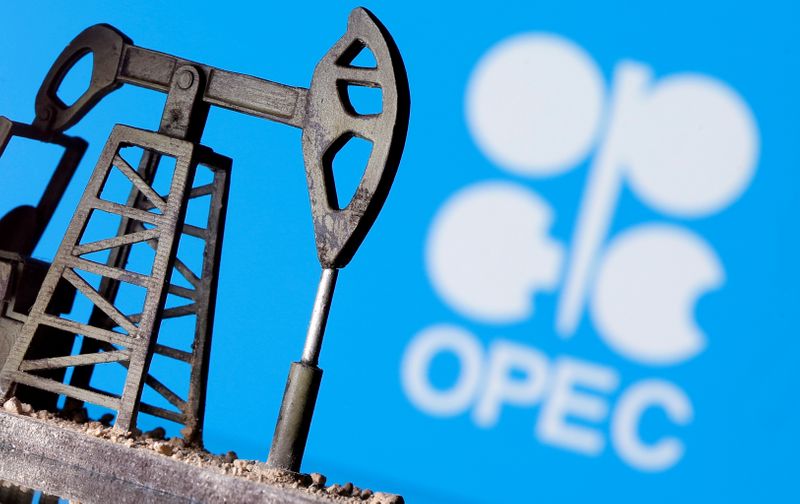
OPEC+ must plan exit strategy: Kemp
by ReutersBy John Kemp
LONDON (Reuters) - Saudi Arabia and its allies in the expanded OPEC+ group of oil-exporting nations have only just started to implement output cuts, so it might seem premature to start talking about the need for an exit strategy.
But an important part of being a successful market manager is about knowing when to increase production and capacity to forestall excessive investment by rivals and potential rivals.
OPEC's biggest problem has always been increasing output in a timely manner after a price slump – rather than continuing to withhold supply in the hope of even higher prices.
Following output reductions in 2009, 2017 and 2019, Saudi Arabia and its allies restrained production too long and allowed prices to rise too high (https://tmsnrt.rs/3gnTXBM).
The result was a sharp increase in output from rival producers, especially the U.S. shale sector, which ultimately seized market share, contributed to a new price slump, and put OPEC back at square one.
The cycle of overproduction, price slump, OPEC cuts, inventory draws, unsustainable price rises, surging shale output and renewed oversupply has created enormous volatility.
If Saudi Arabia and its OPEC+ allies want to moderate the cycle this time they need to react to price increases as quickly and aggressively as price slumps.
In particular, Saudi Arabia needs to see inventory draws and rising prices as a signal to increase its own output before shale producers fill the gap.
FINDING RIGHT PRICE
Saudi Arabia tried to keep prices above $100 per barrel during the first shale boom (2012-2014) and then above $70 per barrel during the second shale boom (2017-2019).
Both times, informal targets were too high and led to an unsustainable increase in U.S. shale as well as limiting global oil consumption growth, creating conditions for a subsequent price crash.
U.S. shale producers captured all or almost all of incremental global oil consumption in five of the last eight years (2012-2014 and 2018-2019) when Brent averaged $65 per barrel or more.
Saudi Arabia and the other members of OPEC+ only managed to recover lost market share or maintain it in three years (2015-2017) when Brent averaged $56 or less.
By the start of 2020, with prices in the $50-60 range, Russia had become disillusioned by the continued loss of its market share to the U.S shale industry, and started to press for OPEC+ output increases.
Russia seems to have concluded $50 or slightly higher was sustainable, but Saudi Arabia was pushing for continued output restraint and prices at $70 or more, reflecting its higher revenue needs.
STRIKING A BALANCE
If Saudi Arabia and Russia are to avoid a repeat of their previous disagreement, and a resumption of their volume war, they need to start thinking now about how and when to exit from their current output-limiting agreement.
OPEC+ has pre-announced a production schedule through to the end of the first quarter of 2022, under which output is supposed to increase gradually, but it takes no account of prices.
Brent has already risen to more than $35 per barrel, up from a recent low of just $20 at one point last month. If the oil market moves into a supply deficit within the next few months, prices are likely to continue rising.
Saudi Arabia, Russia and U.S. shale producers need to identify a combination of price and output that will share out recovering consumption among them in a sustainable way.
Communicating how Saudi Arabia and Russia will adjust their output in response to prices will provide an important signal for investment planning by shale firms and other oil producers.
For Russia and Saudi Arabia, the price trigger could be as simple as saying they will start to increase production if average prices hit a pre-defined threshold for three months or more.
OPEC tried something similar with an oil price band of $22-28 between 1999 and 2003, before quietly abandoning it when prices breached the upper limit.
History shows OPEC has never been good at a timely and managed increase in output. But the alternative to timely production increases is a continuation of boom-bust.
Related columns:
- Successful OPEC+ output deal fits a pattern (Reuters, May 19)
- Saudi Arabia tries shock tactics to bring oil war to swift end (Reuters, March 10)
- Russia's 'nyet' is best outcome for OPEC (Reuters, March 6)
- OPEC must think about exit strategy (Reuters, Oct. 25, 2017) Click here https://uk.reuters.com/article/oil-opec-kemp/column-opec-must-think-about-exit-strategy-kemp-idUKL8N1N05FA